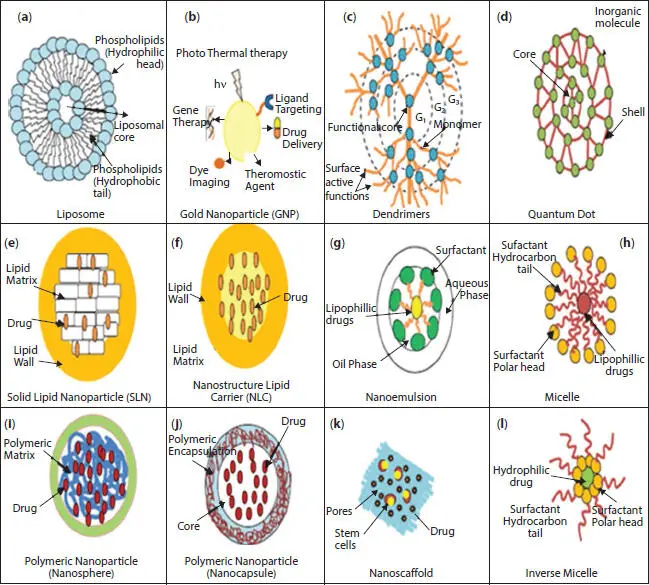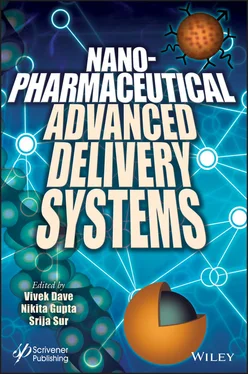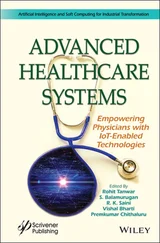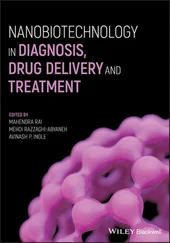Keywords:Polymeric nanoparticles, lipidic nanocarriers, thernostics, SPIONs, SEEDS, applications, regenerative medicine, phagokinetics
| SLNs |
Solid lipid nanoparticles |
| NLCs |
Nanostructured lipid carriers |
| ULVs |
Unilamellar vesicles |
| MLVs |
Multilamellar vesicles |
| PLNs |
PEGylated-lipid nanoparticles |
| siRNA |
Small interfering RNA |
| HCC |
Hepatocellular carcinoma |
| P-gp |
P-glycoprotein |
| RGD |
Arginine-glycine-aspartic acid |
| CSLNs |
Cationic solid lipid nanoparticles |
| DOPE |
Dioleoylphosphatidylethanolamine |
| PG |
Phosphatidylglycerol |
| PS |
Phosphatidylserine |
| PC |
Phosphatidylcholine |
| RES |
Reticuloendothelial system |
| NIPAM |
N-isopropylacrylamide |
| HT |
Hyperthermia |
| Tm |
Phase transition temperature |
| CMC |
Critical micellar concentration |
| AuNPs |
Gold nanoparticles |
| SPR |
Surface plasmon resonance |
| SPIONs |
Superparamagnetic iron oxide nanoparticles |
| MPI |
Magnetic particle imaging |
| PEI |
Poly(ethylenimine) |
| CST |
Critical solution temperature |
| LCST |
Lower critical solution temperatures |
| UCST |
Upper critical solution temperature |
| NDV |
Newcastle disease virus |
| ISCOMs |
Immuno-stimulating complexes |
| FDA |
Food and Drug Administration |
| NAP |
Neuroprotective peptide |
| Lf |
Lactoferrin |
| Pep-H |
Peptide H |
| Mtb Ab |
Mycobacterium tuberculosis Antibody |
| SEDDS |
Self-emulsifying drug delivery system |
| SMDDS |
Self-microemulsifying drug delivery system |
One can witness the multitudinous furtherance made by researchers in the field of medicines. Multifarious research has been done in not just discovering new drugs and their targets but also casting the unique ways that could deliver the drug of interest to the desired site with maximum efficacy and minimal side effects. Novel drug delivery systems in relation to conventional drug delivery systems offer advantages of controlling the fate of drugs in the body with minimal fluctuations in plasma-drug concentration. Apart from these core advantages, they also provide target specificity, improved bioavailability, lesser side effects, and better absorption profile. Nanotechnology has opened newer avenues of applications of novel drug delivery systems by providing target specificity to the carriers achieved by engineering the surface of the carriers with moieties that can attach to receptors expressed abundantly by the diseased cells [1]. Nanoscience has revolutionized the field of drug delivery, tissue engineering, biosensors, and nano-biotechnology [2, 3]. Nanomaterials are considered as particles having size less than 100 nm in any one dimension. Based on this criterion, the nanomaterials are classified as zero-dimensional (0D), one-dimensional (1D), two-dimensional (2-D), and three-dimensional (3D). Particles are considered as 0-D nanomaterials when all the dimensions are in the nanoscale range, i.e., less than 100 nm. Two out of three dimensions in 1-D nanomaterials are in the nanoscale range (one dimension is in the macroscale range). Nanotubes, nanofibers, and nanorods are examples of 1-D nanomaterials. The 2-D nanomaterials have only one dimension in the nanoscale range; examples include nanofilms and nanocoatings. Bundles of nanotubes or nanorods, multilayer of nanofilms in which all the dimensions are in the macroscale range, are considered as 3-D nanomaterials [4].
Polymers (natural or synthetic), lipids, or metals are used in the preparation of nanoparticulate carriers, which impart characteristic properties to these carriers. The composition and method of preparation of nanocarriers define the micromeritics, surface morphology, chemical properties, mechanical properties, magnetic properties, conductivity, and stability [1] Owing to their nanosize, these carriers can be transported via active or passive mechanisms across the biological barriers/tissues/cells and deliver drug at the target site [2, 3]. Endocytic absorption of nanocarriers is one such mechanism that results in improved bioavailability of drugs, especially the poorly soluble ones. Alongside drugs, nanocarriers are also being used for delivery of genetic material, viz. DNA or RNA [5].
2.2 Classification of Nanoparticulate Carriers
Broadly, the nanoparticulate carriers ( Figure 2.1) can be categorized as lipid-based systems, micelles, thernostics, polymeric carriers, and self-emulsifying drug delivery systems (SEDDSs) ( Table 2.1a). The lipid-based systems consist of concentric assemblies of one or more lipid bilayers, formed from amphiphilic building blocks in the presence of water. Liposomes, solid lipid nanoparticles (SLNs), nanolipid carriers (NLCs), etc. belong to this category. SEDDSs correspond to the emulsion-based lipidic systems prepared using surface active agents that self-emulsify in the gastrointestinal tract. Micelles, reverse micelles, etc. employ micellar solubilization of drug in the aqueous phase. Each of these categories has been briefly discussed in the following sections. The list and the classification, though exhaustive, are not limited. Various parameters need to be considered while choosing the carrier system for drug delivery, viz. the interactive forces between the nanocarriers and the biological environment, morphology of the target tissue, conductivity and mechanical properties, composition, size and surface characteristics, drug loading and drug retention capacity, and mechanism of release of drug from the carriers. Recently, due to non-responsiveness to the conventional treatment therapy, application of nanocarriers for the treatment of tuberculosis is also being proposed. Table 2.1bmentions various types of nanoparticulate carriers that are being studied for treatment of tuberculosis.
2.2.1 Lipid-Based Nanocarriers
Liposomes, solid lipid nanoparticles (SLNs), nanolipid carriers (NLCs), phytosomes, etc., are lipid-based nanocarriers. The functionality of lipid-based carrier systems is based on the type and arrangement of the constituent lipids [11, 12]. Both solid and liquid lipids can be used in the preparation of these carrier systems. Alec Bangham discovered liposomes in early 1960s and defined them as vesicular structures consisting of bilayers of phospholipids and hydrophilic aqueous compartment(s) arranged concentrically [13]. The fluidity of the bilayer depends on the degree of saturation of phospholipids used in the preparation of liposomes. Relatively rigid and stable bilayers are formed by saturated phospholipids with long acyl chains (e.g., dipalmitoylphosphatidylcholine) in comparison to those formed using unsaturated lipids like phosphatidylcholine from natural sources (egg or soybean phosphatidylcholine) [14].

Figure 2.1 Diagrammatic representation of various nanoparticulate carriers: (a) liposome; (b) gold nanoparticle (GNP); (c) dendrimers; (d) quantum dots; (e) solid lipid nanoparticle (SLN); (f) nanostructured lipid carriers (NLC); (g) nanoemulsion; (h) micelles; (i) polymeric nanoparticle (nanocapsules); (j) polymeric nanoparticle (nanospheres); (k) nanoscaffolds; and (l) inverse micelle.
Читать дальше













